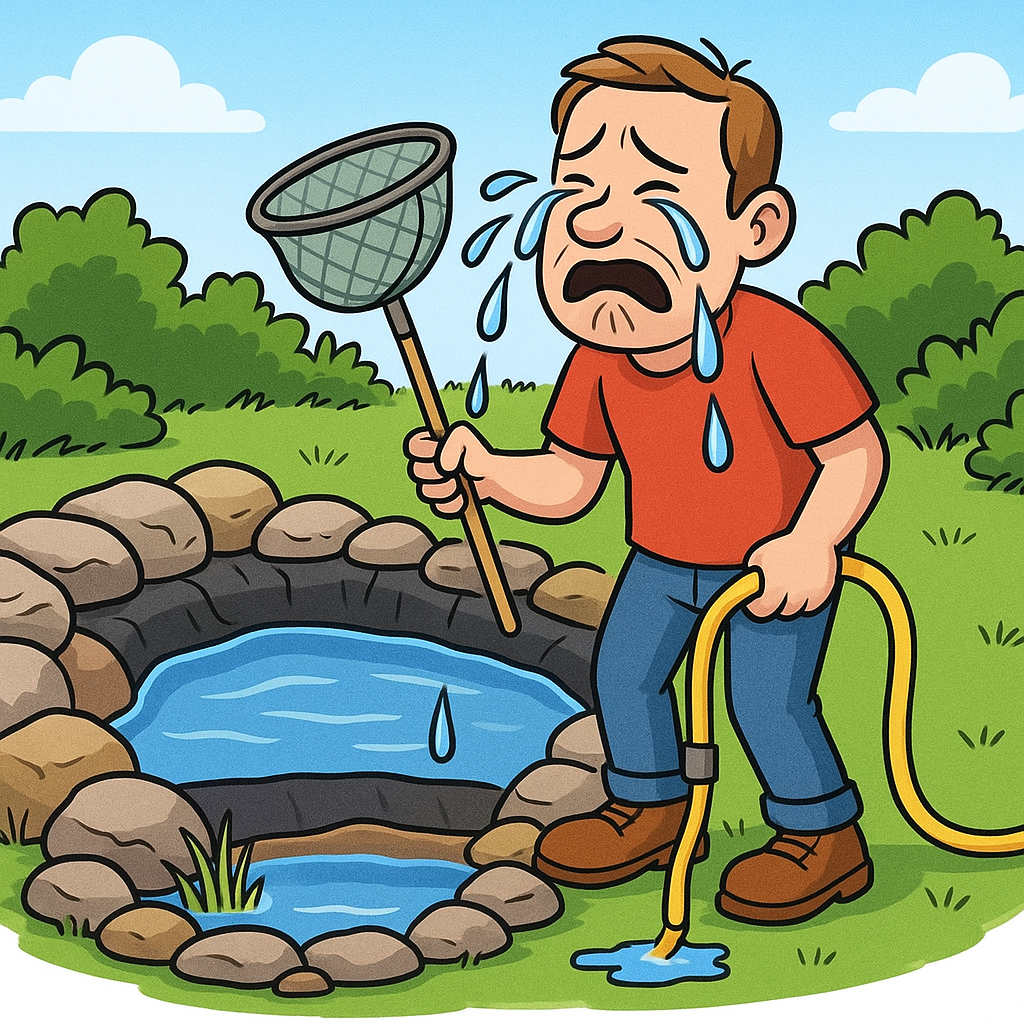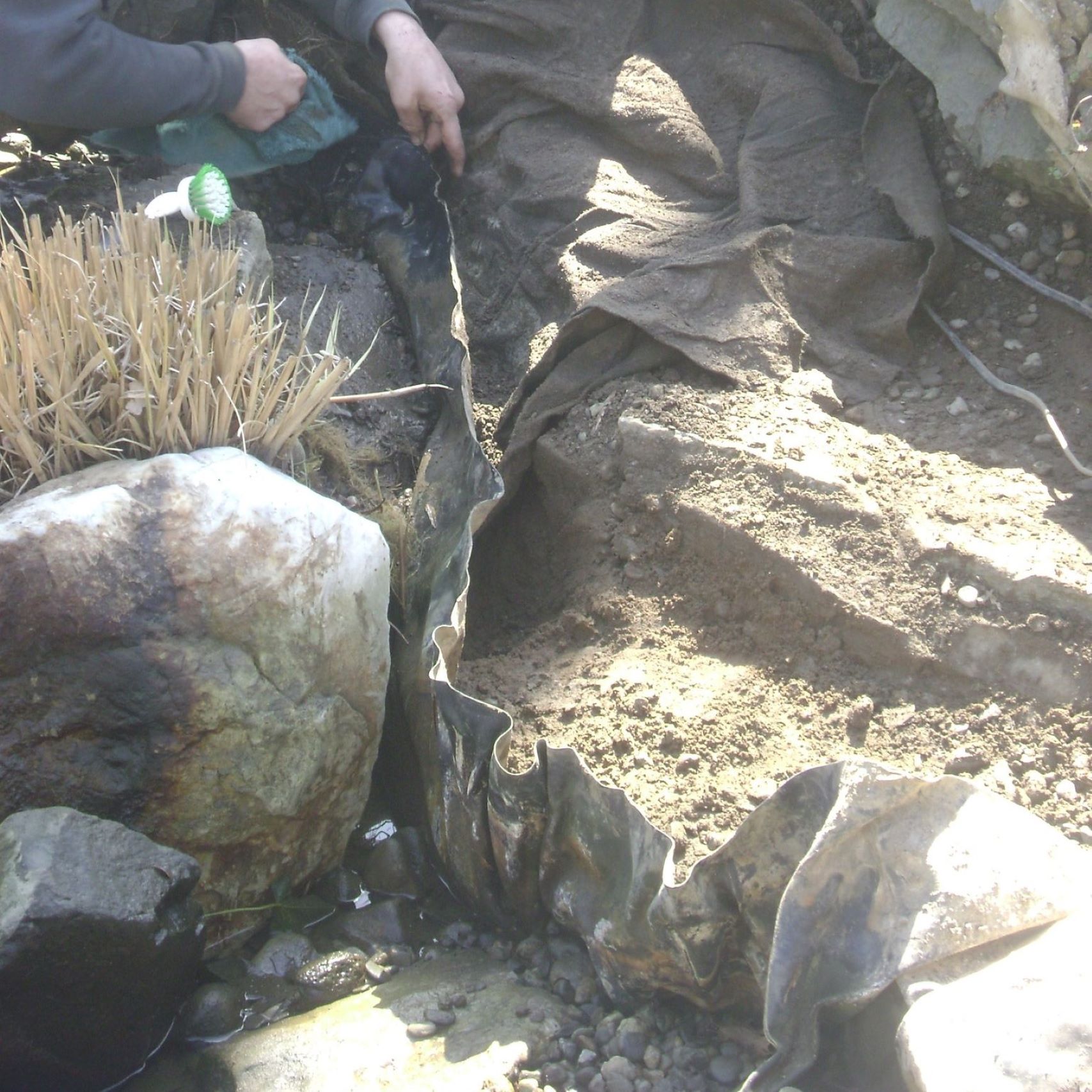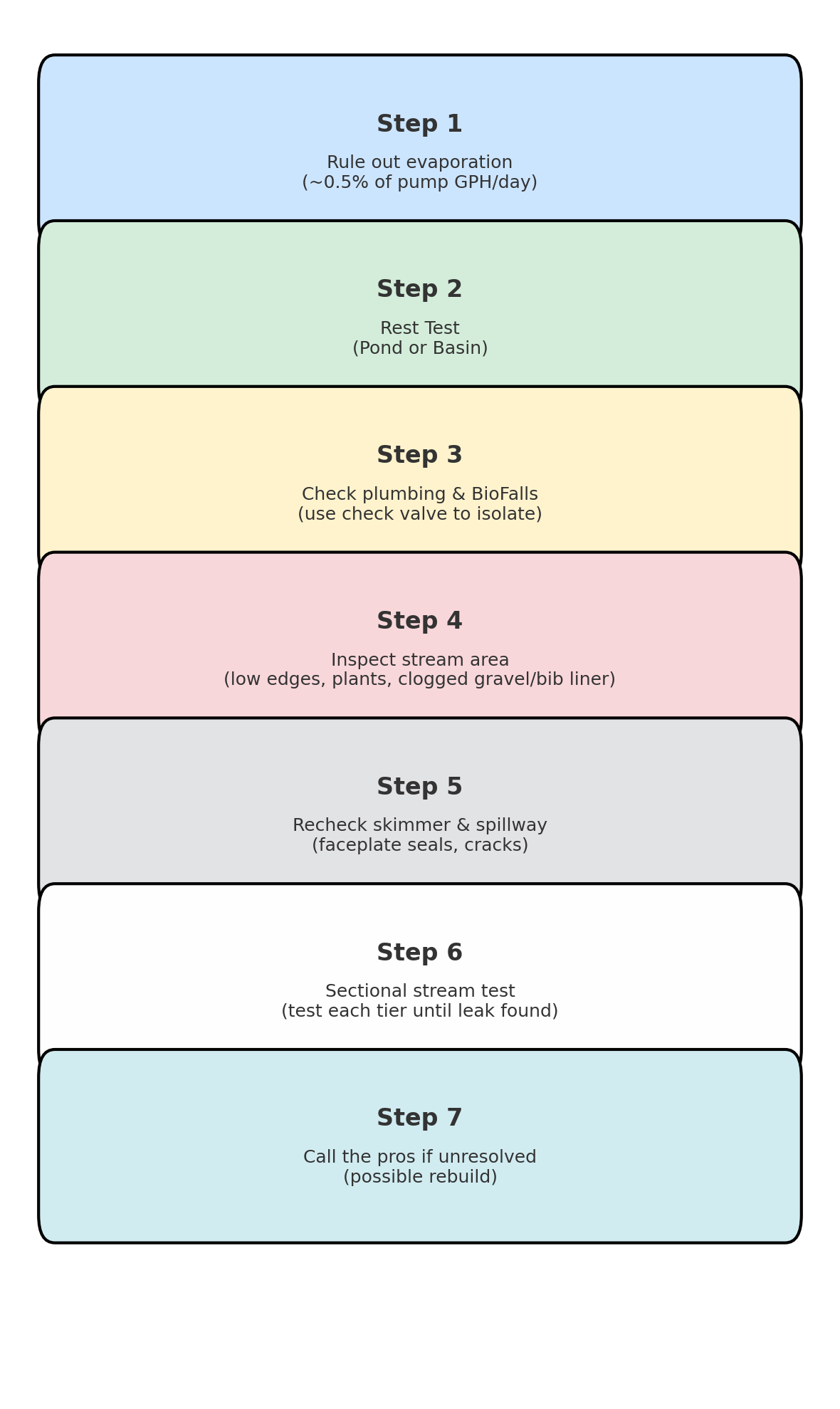From the pond pros at Pond King Water Gardens
A beautiful pond or pondless waterfall is like having your own backyard oasis, until you start topping it off every single day and muttering to yourself, “Where is all my water going?!”
Good news: not all water loss is a leak. Bad news: when it is a leak, finding it can feel like searching for a needle in a haystack… except you don’t know how many needles there are, or where the haystack even is.
We’ve been at this a long time, and though our features rarely have any issues, we have seen and heard about many scenerios and want to be here as a resource for you! This is why we’ve created a step-by-step Leak Protocol. Follow this, and you’ll either find your leak or decide it’s time to let the pros (like us 😉) take over.

Step 1 – Rule Out Good Ol’ Evaporation
Before you start digging around like a raccoon in the night, make sure it’s not just the sun, wind, and splash stealing your water.
Evaporation changes daily depending on:
– Hot, dry, or windy weather
– Rain or no rain
– Size of open water surface & pooling areas
– Splashing from waterfalls or streams
Quick math rule:
Expect up to 0.5% of your pump’s GPH in gallons lost per day to evaporation.
Example: Pump flows 7,000 GPH (after head pressure) → up to ~35 gallons/day evaporated with zero leaks. These are rough numbers keep in mind.
If you’re losing more than that, move on to Step 2.
Step 2 – The Rest Test (a.k.a. Start at the Bottom)
The rest test rules out the pond or basin as the culprit before you go climbing around your waterfalls and moving things around.
For Ponds:
1. Fill to normal level.
2. Turn auto-fill OFF and keep below overflow.
3. Mark the water level on something solid.
4. Shut the system OFF for at least 24 hours.
5. Check:
– If it holds → your leak is higher up (probably stream or plumbing only losing water while running).
– If it drops → let it keep dropping until it stops. Leak is just above that stabilized waterline.
For Pondless Waterfalls:
Do the same process for the basin/reservoir.

Step 3 – Check Plumbing & BioFalls
A check valve (preferably at the pump) is your best friend — it keeps the plumbing and BioFalls full so you can rule them out without digging.
Plumbing problems can happen from:
– Freeze/thaw cycles in Minnesota (pipes crack)
– Settling in the ground causing low spots
– Tree roots pressing on lines
– Shovel hits
– Cracked fittings, bulkheads, and NPT connections (sometimes hiding underneath where you can’t see 👀) If the check valve is working and your plumbing is holding water, proceed to turn on the waterfalls again to begin the next steps. After running the system, look for obvious wet spots.

Step 4 – Inspect the Stream Area
If your rest test holds but you still lose water when running, 9 times out of 10 the problem is here.
Common stream/basin issues:
– Low edges → water sneaks over where liner’s too low, especially near frame rocks. Rocks could also settle and push the liner down.
– Overgrown plants pushing down liner.
– Basin bib liner clogs → sediment build-up slows water from getting into aquablocks.
– Clogged basin gravel → leaves, pine needles, algae, and mineral buildup block gaps, forcing water over and out.
🍂 Fall Tip: Leaf debris can dam up a stream or clog a basin faster than you think. One good gust of wind and you’ve got your own unplanned water diversion project.
Pro tip: Sometimes replacing just a few buckets of clogged gravel in the basin/reservoir fixes it.
Step 4 – Inspect the Stream Area
If your rest test holds but you still lose water when running, 9 times out of 10 the problem is here.
Common stream/basin issues:
– Low edges → water sneaks over where liner’s too low, especially near frame rocks. Rocks could also settle and push the liner down.
– Overgrown plants pushing down liner.
– Basin bib liner clogs → sediment build-up slows water from getting into aquablocks.
– Clogged basin gravel → leaves, pine needles, algae, and mineral buildup block gaps, forcing water over and out.
🍂 Fall Tip: Leaf debris can dam up a stream or clog a basin faster than you think. One good gust of wind and you’ve got your own unplanned water diversion project.
Pro tip: Sometimes replacing just a few buckets of clogged gravel in the basin/reservoir fixes it.

Step 5 – Recheck the Skimmer & Spillway
Skimmer faceplates are literally holes in the liner — over time, seals can fail.
– Low-quality brands can crack outright.
– BioFalls faceplates and spillway fittings can also leak (we’ve seen fittings crack on the bottom, like they’re laughing at you because you can’t see them 🙃).
-Typically the rest test will reveal this by the level dropping but the spillway at the top could be something to keep in mind if the next sectional test takes you all the way up with no leaks which we have seen before.
Step 6 – Sectional Stream Test
If you’ve ruled out the rest, it’s time for detective work:
1. Hook a temporary hose from your pump to feed just the lowest waterfall tier.
2. Run 12–24 hours, measure water loss.
3. If no loss → move to next tier.
4. Repeat until you find the leaky section. If you find no leaks on the tiers, it is usually the fitting on the back of your waterall spillway or biofalls.
Rodents chewing holes? Deer stepping in? Random rock shift? Yup, all possible.
Extra Clues
– Plants thriving way more in one spot? They might be sipping on your leak.
– Soft, wet soil near pond? Could be underground leak.
– Random soggy area downhill from feature? Follow the trail.
Step 7 – Know When to Call It
Leak hunting can burn days (and dollars) fast. If:
– You didn’t build it and don’t know its history
– It’s a DIY project with mystery materials
– You’ve got multiple small issues instead of one big one
…you might be better off investing in a rebuild. And yes, we’d love to throw our hat in the ring 😉 — preferably building you a work of art designed to last for years without surprise leaks.

Bottom Line
Whether you follow this guide step-by-step or decide to hand it off to a Certified Aquascape Contractor (preferably a Master level Regional Artist of the Year winner like… oh, I don’t know… Pond King Water Gardens 😉), we’re here to help. Contact Us today to learn more!

